Yesterday’s liveblog can be found here. An archive of our liveblogs can be found here. For an overview and analysis of this developing story see our latest podcast.
Please help The Interpreter to continue providing this valuable information service by making a donation towards our costs.
View Ukraine: April, 2014 in a larger map
For links to individual updates click on the timestamps.
For the latest summary of evidence surrounding the shooting down of flight MH17 see our separate article: Evidence Review: Who Shot Down MH17?
Below we will be making regular updates so check back often.
Censor.net reported this afternoon,
citing unconfirmed reports, that fighting continued in three districts:
Petrovsky, Kievsky and Kuybyshevsky, with some damage to buildings and
injuries of civilians.
Work continues on restoration of electrical
power. Six sub-stations in Kuybyshevsky and Kievsky districts were
restored, leaving 43 more to go. Public transportation is operating, but
with detours around areas of combat, designated on the mayor’s office
website..
Earlier today Censor.net reported
that due to shelling, the building at 88 Krupskaya St. in Kievsky
District was totally destroyed. Due to major shelling of gas lines,
about 50 streets lost gas, mainly in the private sector.
A video was uploaded with today’s date and the title, “Donetsk. Grad system firing 30.09.2014. Shirokiy”
The blogger @djp3tros from Ukraine@War has geolocated the video here on Google Maps for The Interpreter.
This screenshot shows an unfinished building with a fence near a field with
trees and a path leading alongside it, and the port and fields in the distance.
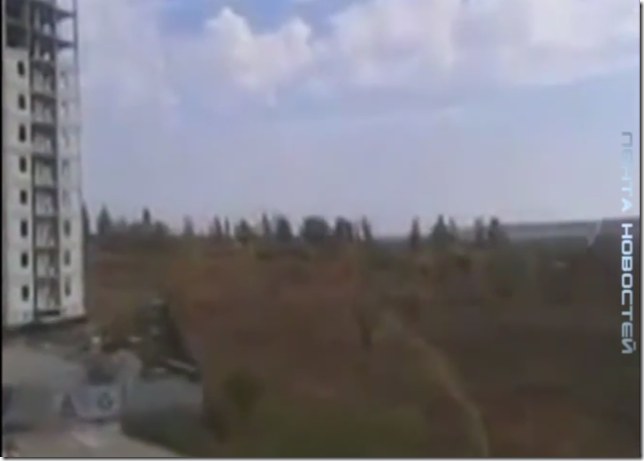
This camera position, line of sight and Grad trajectories are marked on this screenshot:
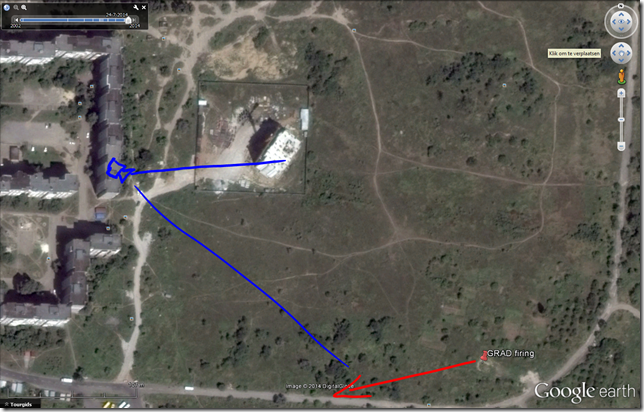
With a range of 20 kilometers, the Grad missiles are fired toward the town of Marinka:
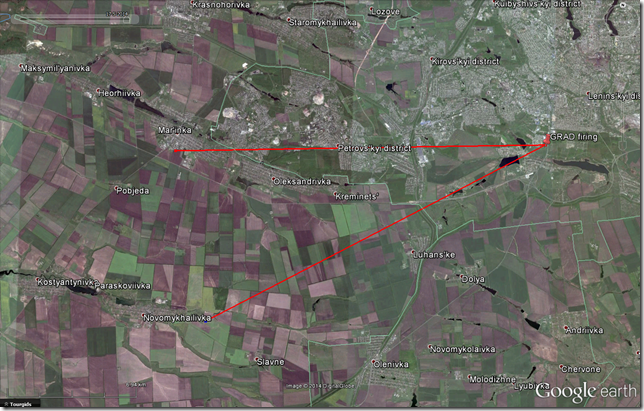
The Russian MilitaryMap reports that there are Ukrainian positions here, as marked:

Another video uploaded today to YouTube and labelled “Makeyeva, shelling from residential districts 30.09.2014.”
This screenshot shows the view from the camera position.
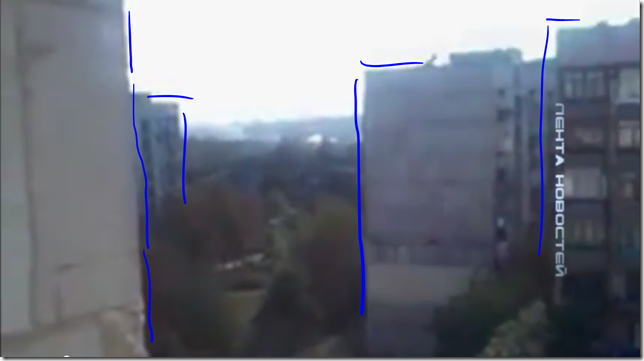
This is marked on the map as follows:
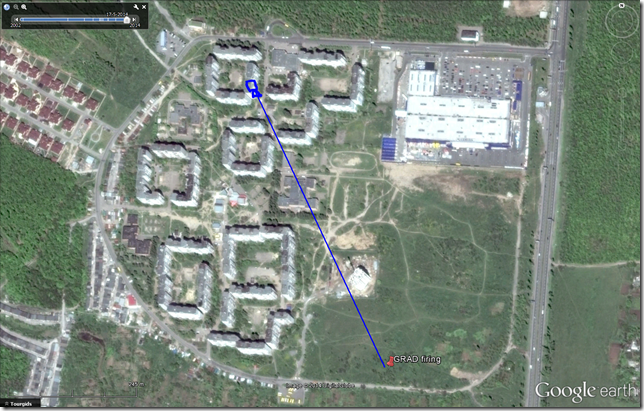
This Grad has a slightly different position compared to the previous
video. Either this was within the margin of error, or there was another Grad firing separately.
And…so much for the ceasefire.
Another copy of the video:
Last week we reported that several members of parliament who belong to the Party of Regions, the party of ousted president Viktor Yanukovych, were harassed in Kiev. Protesters eager to see them leave the government or perhaps be prosecuted literally threw Viktor Pylypyshyn and Vitaliy Zhuravsky into the trash last week.
Today another Party of Regions MP, Nestor Shufrych, was attacked in Odessa. RFE/RL reports:
A mob of about 20 attacked Shufrych as he tried to enter the main regional municipal building in Odesa. Some attackers wore masks, camouflage fatigues, and armbands of the right-wing nationalist Right Sector group.
Shufrych is a critic of Kyiv’s military campaign against pro-Russian separatists in eastern Ukraine.
His supporters said Shufrych was campaigning on behalf of an opposition bloc running against pro-Western and Ukrainian nationalist parties.
The video below, which may be disturbing, shows the assault on Shufrych. Nearby, some in the crowd are flying the red and black flags of Pravy Sektor, or Right Sector, the Ukrainian ultranationalist party whose candidate Dmitro Tarosh received less than 1% of the votes in the recent presidential election.
This is a cross-post from our Russia This Week liveblog.
The Russian ruble continues to bleed value this week.
Translation: the Russian ruble has fallen to a new record low. How to stop this fall? .0253 rubles per dollar
There are reports that Moscow is considering capital control measures, though Moscow is denying this. Nasdaq reports:
The Russian ruble hit a fresh record low against the central bank’s target basket of U.S. dollars and euros, slipping below the level at which the bank intervenes to support the currency, amid fears that Moscow may consider capital controls to stem the flow of money out of the country.
The ruble recovered slightly after the central bank and the Finance Ministry said they aren’t considering such restrictions. It had slid to more than 44.40 rubles to the basket after Bloomberg cited two unnamed Russian officials as saying the bank was considering temporary capital controls if capital outflows intensified.
The drop Tuesday underscores nervousness around the ruble, which has dropped nearly one-fifth against the U.S. dollar this year, battered by large capital outflows and an economy close to stagnation amid Western sanctions.
The ruble closed at 44.25 to the euro-dollar basket after briefly touching 44.52, crossing the threshold at which the central bank starts selling dollars and euros to smooth fluctuations. The ruble also hit an record of 39.89 against the dollar before recovering to 39.57 by the end of the day.
Russian officials were quick to deny the report of considering capital controls, which Russia scrapped in 2006. A Finance Ministry official, who asked not to be named, said the ministry would be against such a move, even if the government were considering it. Net outflows are forecast at $100 billion this year.
As we’ve been reporting since last week, one of the main causes for the sudden fall in the ruble is the confirmation of a lawsuit which will nationalize Bashneft, an oil company which is now a division of the Russian conglomerate Sistema (headed by Vladimir Yevtushenkov). Yevtushenkov, who reportedly has connections to the Ukrainian separatists, was put under house arrest, sparking fear among investors that Russia is once again trying to exert greater control over the energy sector and reminding some of the imprisonment of Mikhail Khodorkovsky more than ten years ago.
Yesterday Sistema’s stock plummeted, helping to push the Russian stock index MICEX down. ITAR-TASS reports:
The Sistema stock fell by 20.3% to 13.550 rubles ($0.34) per share compared with a 0.09% fall in the MICEX stock index and a 1.14% decline in the RTS stock index.
Sistema’s stock was falling by 7-10% in early Monday trading on the Moscow Stock Exchange on Monday and then accelerated its plunge in the afternoon to 15.6% to 14.350 rubles ($0.36) per share.
Bloomberg, however, notes that the struggling MICEX has more to do with the tumbling ruble than with stock selloffs:
While the RTS gauge, which is quoted in dollars, is down 21 percent from a six-month high reached June 24, the benchmark Micex Index (INDEXCF), which is denominated in rubles, has only lost 7.3 percent over that time. The ruble’s performance in the past three months — a 14 percent tumble that’s the biggest decline among all currencies tracked by Bloomberg — accounts for the difference.
“The plunge in the ruble is affecting the RTS, and it looks like there will be further pressure on the currency,” Kirill Yankovsky, director of equity sales at Otkritie Capital, said by phone from London yesterday. “The RTS index hasn’t had an opportunity to leave the bear market for most of this year, it was down with just a few rebounds, and there is little incentive for the index to go up.”
The RTS has plunged since June as international sanctions against Russia for its involvement in the Ukrainian conflict prompted investors to pull money out of an economy that’s on the brink of recession. The gauge completed its first 20 percent drop that commonly defines a bear market in March as President Vladimir Putin annexed the Crimean peninsula. It then rebounded in May as the central bank intervened to strengthen the ruble and tension in eastern Ukraine eased.
Today the MICEX is actually up, but only by .2%, following a substantial day of losses.
The bottom line — after months of tensions and increasingly costly sanctions, new worries are deterring investors and weakening the value of Russia’s currency. Since the economic outlook for Russia before all of these events was not terribly promising, without new and better news for investors there is no indication that either the ruble or Russia’s markets are likely to rally any time soon.
Yesterday and today are the anniversary of the most notorious massacre in Ukraine at Baby Yar (also known as Babyn Yar) during which 33,771 Jews were killed on the night of 29-30 September 1941 by the Nazis in occupied Kiev.
Other groups of people including Ukrainian nationalists, communists, Roma, and POWs were also killed at this site over time, numbering 100,000-150,000 victims.
The anniversary continues to generate controversy and continues to be remembered by some as “a massacre of Soviet people” without specific reference to Jews — which was Soviet policy for decades.
Translation: Tragedy of Baby Yar 29 September 1941, at Baby Yar the Germans executed more than 150,000 people.
Translation: Ceremony in memory of the victims of Baby Yar.
The occasion continues to cause bitter reproaches over the role of some Ukrainians who collaborated with the Nazis, although Ukrainian soldiers also fought the Nazis in World War II and Ukraine suffered large numbers of casualties.
Translation: As for Baby Yar, my grandmother told me that in Kiev, there were a lot of polizei, working for the Germans.
President Petro Poroshenko marked the occasion by laying flowers at the
monument. He published two tweets in Ukrainian and English.
Translation: Petro Poroshenko at a ceremony to commemorate the victims of Baby Yar: Ukraine will never permit the restoration of fascism.
Translation: Poroshenko knelt before the memorial to the victims of Baby Yar.
But he then went to lay flowers at a monument to the OUN (Organization
of Ukrainian Nationalists), a controversial ultranationalist partisan
group that carried out assassinations against Polish and Ukrainian
public figures and was also notorious for pogroms against Jews. Stepan
Bandera, the controversial Ukrainian hero also involved in atrocities — today better known from the Kremlin’s anti-Ukrainian propaganda than from his few actual followers — was a member of this group.
The action caused a storm of reactions in social media, and was seized on by supporters of the Russian-backed separatists as proof of Kiev’s supposed “fascist” leanings:
Translation: On the day of commemoration of the victims of Baby Yar, Poroshenko laid flowers to the henchmen from the OUN-UPA.
Translation: On the day of memory of victims of Baby Yar, Poroshenko lay “flowers at a memorial Cross for the members of the underground OUN.” Flowers for the henchmen of Baby Yar.
Translation: Who else will dare to call Poroshenko Valtzman on the day to memory of the victims of Baby Yar lay flowers to the OUN.
This last tweet relates to a notion that Poroshenko has Jewish heritage indicated by his father’s surname “Valtzman,” an antisemitic conspiracy meme popularized by the Russian state media, Russian government front groups and leftwing blogs in the US, although his Wikipedia entry does not contain this.
Poroshenko’s diametrically-opposed flower-laying actions are indicative of the fine line he is walking among different political forces in Ukraine.
Reports are coming in of continued heavy fighting around the government-held Donetsk Airport, to the north of the separatist-held city.
The official website of the mayor of Donetsk, Oleksandr Lukyanchenko, reports that, as of 18:30 local time, heavy fighting is under way in the north of the city.
According to the council, a shell struck a high-voltage power line knocking out several substations, leaving swathes of the Kievsky, Voroshilovsky and Kuybyshevsky districts without power.
There is no denying that the fighting in Ukraine is significantly lessened since the signing of a ceasefire agreement. However, while eastern Ukraine could be considered a frozen conflict like so many Russian conflicts before it, there is still fighting ongoing. Lessened fighting has likely reduced the need for large numbers of Russian troops in eastern Ukraine, but many Russian troops remain in Ukrainian territory, according to NATO.
Russia still has hundreds of troops in Ukraine despite a “significant” force withdrawal made since Kiev and pro-Russian rebels agreed a cease-fire earlier this month, NATO said Tuesday.
After the pullback, “hundreds of Russian troops, including special forces, still remain inside Ukraine,” NATO spokesman Jay Janzen said, adding that no further reduction had been seen in the past week and that some 20,000 soldiers were still deployed near the Ukrainian border.
We’ve been watching Ukraine’s currency closely as its devaluation continues to plague the already weak Ukrainian economy. Yesterday the hryvnia dropped only a single kopeck and closed the trading day at 13.18 hryvnia/USD. Today the currency has been largely stable, with most transactions being conducted at 13.175 UAH/USD. The Ukrainian government has also been trying to find ways to curb currency speculation which they say has hurt the value of the hryvnia.
Ukraine’s National Bank has warned that there are media reports that the separatists plan on printing counterfeit hryvnia banknotes, and those reports are provocations designed to further destabilize Ukraine’s already weak currency.
Meanwhile, in yet another sign that Ukraine’s separatists have zero intention of being part of a united Ukraine, a key separatist leader has discussed adopting the Russian ruble — or even printing their own money:
Self-styled prime minister of the secessionist “Donetsk People’s Republic” Alexander Zakharchenko had said the ruble would be introduced as currency across the rebel held territory in Donetsk region.
“We need three or four months to arrive at partial rejection of the hryvnia and switchover to the ruble,” Zakharchenko told Interfax. “After that, we will think how to give up the hryvnia altogether and join the ruble zone entirely. However, it is too soon to talk about some timeframe here,” Zakharchenko added.
Zakharchenko said the time was not ripe for the “Donetsk People’s Republic” to introduce its own currency. “Any currency must be backed up by something. Hypothetically, we could back up our own currency with the resources we are mining – coal and metal. However, we are not ready yet to introduce our own currency,” Zakharchenko said.
Andrei Stenin, a RIA Novosti photographer, was found dead in eastern Ukraine, near Snezhnoye (known in Ukrainian as Snizhne), in late August. But the conditions under which he died are still a mystery, and as The Interpreter’s in-depth investigation into the case reveals, there are more questions than answers regarding the case. The Russian-state media appears to have been engaged in a series of denials and cover ups, changing details, deleting tweets and entire stories, and hiding important details — like the fact that Stenin was not killed alone but two other bodies were found with him.
In fact, there are dark whispers about the two Russian journalists, Dmitry Steshin and Aleksandr Kots, who found the bodies of three people, including Stenin, and reported them to the OSCE. Were Russian journalists working with separatists leaders like Colonel Igor Strelkov to create a narrative that Ukraine was guilty of war crimes? What is the connection to these journalists and Russian ultra-nationalists? And did these journalists, including Stenin who was killed, know exactly who shot down MH17?
Read our entire investigation here: Andrei Stenin and His Fellow Travelers: How Russian State Media Help Fight the War Against Ukraine
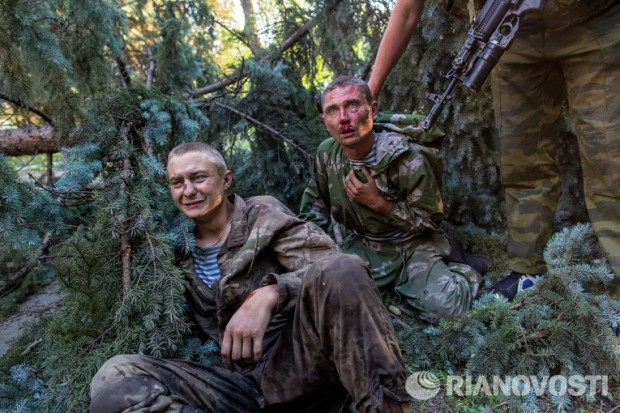
Andrei Panasyuk and another Ukrainian POW. Photo by Andrei Stenin/RIA Novosti
As we reported earlier, the town of Popasnaya (map) has been hit by Grad rockets today. Hromadske TV is running a video and picture gallery along with their report. They say that a hospital had its windows knocked out and all of the ambulances, except once car, were destroyed. Several civilians were killed in the blasts. Shrapnel also appears to have damaged a store nearby.
The article says that without ambulances, it will be hard to treat people who need medical help, which is particularly worrying if there is another rocket attack.
The following pictures were taken by journalist Anastasia Public Stanko, but there are more here.
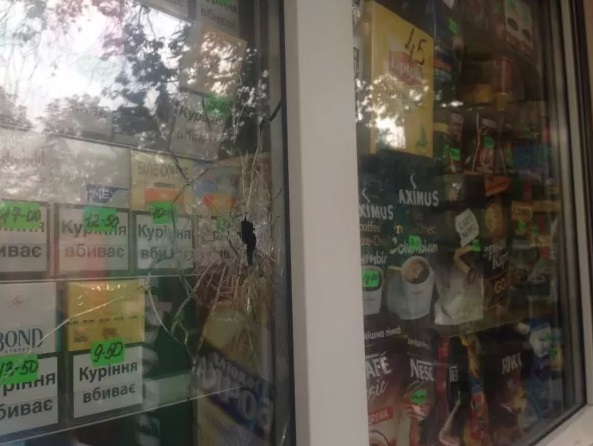

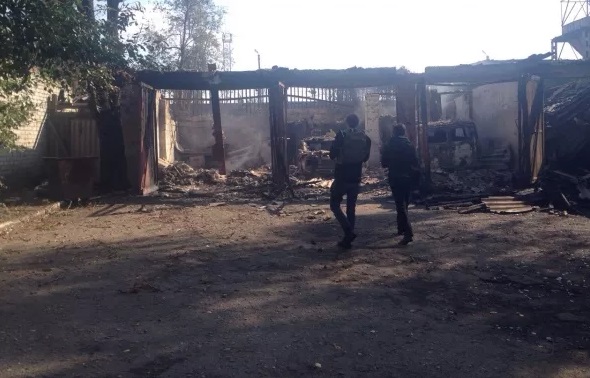
Silver Meikar, an Estonian journalist, has posted pictures from the area:
Moscow today has announced the cancellation of the Future Leaders Exchange (FLEX) program which has brought thousands of Russian students into the United states since 1993. Here is the statement from the U.S. Ambassador John Tefft:
The U.S. Embassy in Moscow was informed today that the Russian Government has decided to cancel Russian participation in the 2015-2016 Future Leaders Exchange (FLEX) Program, the largest U.S.-Russian educational exchange program.
We deeply regret this decision by the Russian government to end a program that for 21 years has built deep and strong connections between the people of Russia and the United States.
For over two decades, the FLEX program has brought more than 8,000 Russian high school students to the United States to live with American host families, attend high school and experience community life for an academic year. These young Russians have served as cultural ambassadors, representing the best of Russia, to millions of Americans throughout all 50 states.
The United States remains committed to exchanges and programs that promote cultural ties and mutual understanding between the Russian and American people.
This is a cross-post from our Russia This Week blog:
Mass graves found outside of Donetsk by Russian-backed separatists of the self-proclaimed “Donetsk People’s Republic” last week have provided an occasion for the Russian government to accuse the Ukrainian government of war atrocities.
This weekend a mass rally was staged in Moscow on this theme titled “Donetsk: Innocents Murdered” at the World War II monument Poklonnaya Gora. Today Russia’s Investigative Committee announced an investigation into “genocide” of Russians in southeastern Ukraine, BBC Russia’s Service reported.
On 24 September, ITAR-TASS ran a news article titled “Russian Foreign Ministry Believes Mass Graves Outside Donetsk Were at the Hands of Ukrainian Forces” (excerpt translated by The Interpreter)
Speaking at a session of the UN Commission on Human Rights, Amb. Aleksey Borodavkin, Russia’s envoy to Geneva, claimed that graves discovered near Donetsk contained “bodies of executed civilians on the territory of Donetsk region which was controlled by the Ukrainian forces. This war crime appears to be precisely at their hand. We will closely follow the assurances of the Ukrainian leadership about the investigation of all these rights violations.”
Borodavkin said that bodies found at the Kommunar Coal Mine No. 22 were determined by forensics experts to be killed by a shot to the head.
ITAR-TASS said the Russian ambassador claimed the territory was under the control of Ukrainian forces and the Aidar Battalion of the National Guard.
The claims appear to involve distortions of a review of the scene of the mass graves by OSCE’s Special Monitoring Mission in Ukraine, and even an admission by Aleksandr Zakharchekno, prime minister of the self-proclaimed “Donetsk People’s Republic,” that some of the victims are Ukrainian soldiers.
The report by the OSCE Special Monitoring Mission dated 24 September in fact stated the following:
The ‘military police’ of ‘Donetsk People’s Republic’ (‘DPR’) told the SMM that three unmarked graves allegedly containing multiple bodies had been found; two of them were located in a coal mine Komunar near the village Nyzhnia Krynka (35km north-east of Donetsk) and one inside the village. The SMM proceeded to the scene and saw in the coal mine two areas located fifty metres apart, each containing two human bodies. All four corpses were in the process of decomposition. The SMM also saw eight 9mm Makarov pistol cartridges approximately five meters away from the bodies. Near the road on the edge of the village, the SMM observed a pile of earth resembling a grave which had a stick with a plaque, written in Russian and containing the names (or in one case – initials) of five individuals. The plaque indicated that the individuals died on 27.08.2014. On top of the plaque there was another inscription saying: ‘Died for Putin’s lies’. Neither in the coal mine nor in the village did the SMM see any forensic experts. COMMENT: The SMM cannot provide a forensic assessment of the sites.
The Russian state media has failed to explain when and by whom the forensic examination was done; OSCE notes that they neither performed one themselves (which is not in their mandate) nor did they see any at the time. The Russian version also kept out mention of the sign on the grave or the exact total of victims.
Meanwhile, Russia media have run a number of stories citing separatists’ claims of “about 40 bodies found” in the graves in Nizhnyaya Krynka (known as Nyzhnia Kyrnka in Ukrainian), although the OSCE report indicates a total of 9 were found. As Moskovsky Komsomolets reported:
“Three graves have been found, in one of there are the bodies of civilians, they discovered about 40 there, and in two others, the bodies of militia POWs and Ukrainian soldiers,” Aleksandr Zakharchenko, prime minister of the self-proclaimed DPR, noting that this territory was under the control of Ukrainian forces for a long time.
RIA Novosti reported on September 25 that Zakharchenko told Russkaya Sluzhba Novosti which originally covered his remarks, “the exact number of mass graves are not known” in three mass graves although he estimated about 40. He said some of the bodies were found without their internal organs.
The Foreign Ministry announced last week that they will attempt to involve the UN, Council of Europe, OSCE and human rights organizations in the investigation of the Donetsk graves. Russian human rights commissioner Konstantin Dolgov also claimed that the territory was under control of the National Guard, which he said pointed to the perpetrators. Dolgov accused the West of “double standards” in seeming to ignore Ukrainian atrocities, although the allegations against Aidar involving documentation of 3 cases have been covered by in detail by Amnesty International andWestern journalists.
The Russian campaign against alleged Ukrainian atrocities may be an effort to distract from other mass graves of 14 victims of Russian-backed separatists found in Slavyansk, some said to be executed on orders of Col. Igor Strelkov, including four Protestant church members who were kidnapped and murdered. The UN High Commissioner for Human Rights documented 812 kidnappings by separatists, some of whom were missing, in a July report.
The head of the Lugansk Regional State Administration, Hennadiy Moskal, has announced that Russian-backed militants have begun shelling the government-held town of Popasnaya (known in Ukrainian as Popasna), less than 10 km west of separatist-held Pervomaysk.
Illegal armed groups of the so-called Luhansk People’s Republic started intensive shelling of the town of Popasna with Grad multiple rocket launchers at about 0930 on Tuesday, Head of Luhansk Regional State Administration Hennadiy Moskal has said on his personal Web site.
“An ambulance station is on fire in the district center, and there are dead and wounded,” the report says.
According to the report, early on Tuesday, Moskal left for the village of Troitske in Popasna district area to assess the impact of yesterday’s shelling of the school and private homes.
“Grad shelling also continues at this moment (as of 0955). The regional governor cannot enter the district center, because shells have completely destroyed a bridge,” the report says.